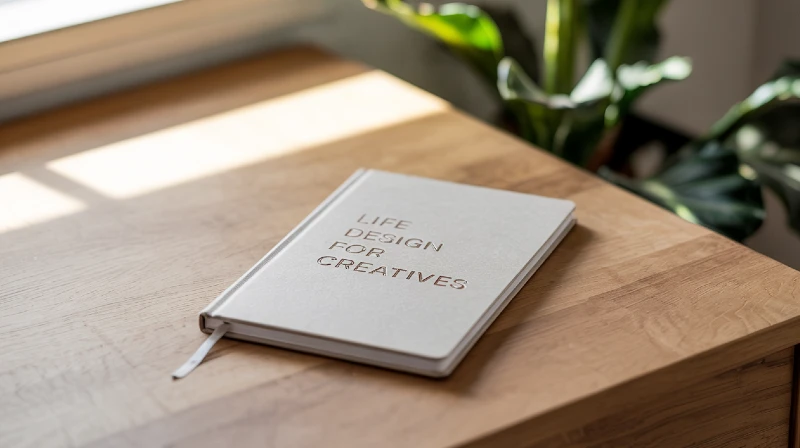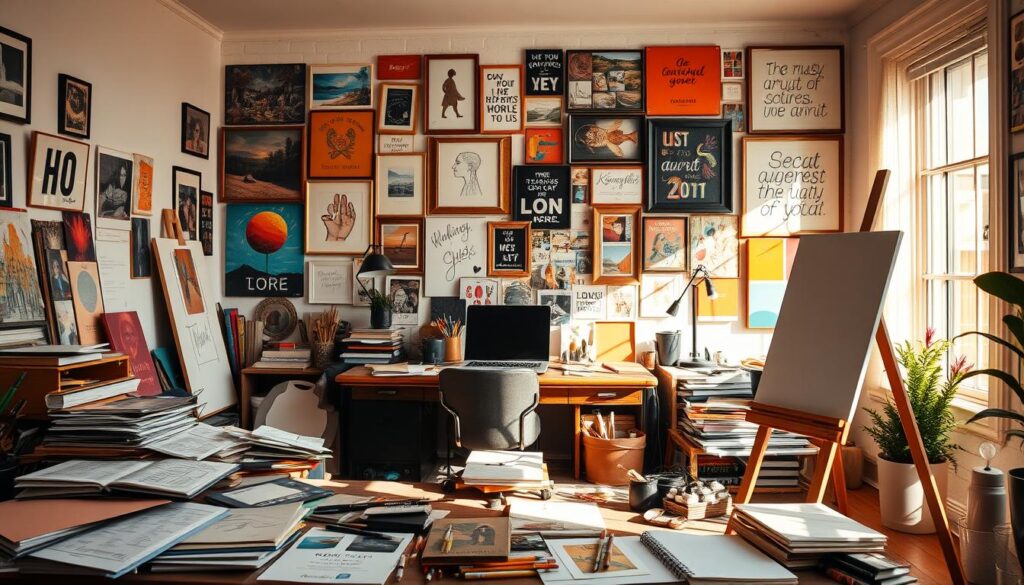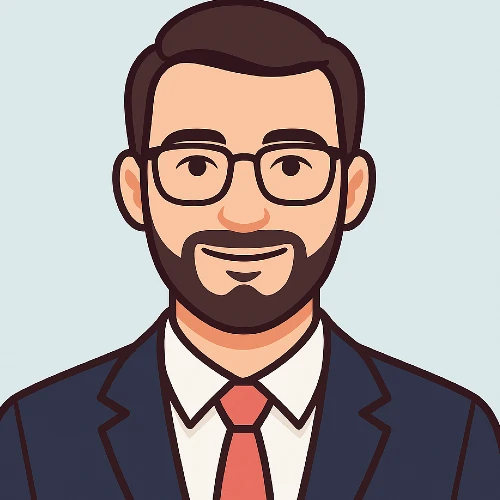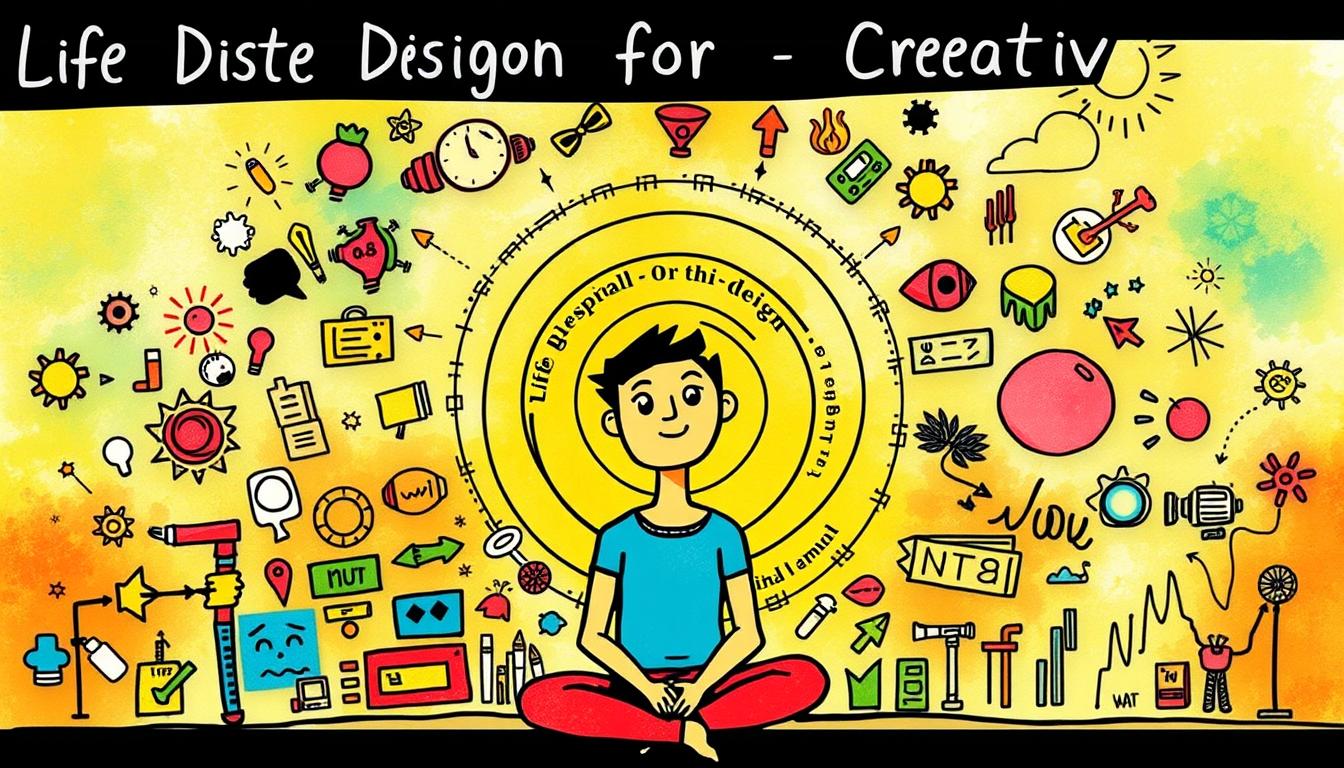Crafting a Fulfilling Life: Life Design for Creatives
Life Design for Creatives is a new way to live a life that matches your passions. Ayse Birsel, a design thinking leader, says, “Life, like a design problem, has its limits. You must be creative to make what you want and need work together.” Artists and designers often find traditional jobs unsatisfying. Over 70% feel stuck in their careers, and 80% say they’re just going through the motions without purpose.
Design thinking for artists turns this problem into a solution. It uses a four-step process: Deconstruction, Point of View, Reconstruction, and Expression. This process turns limits into opportunities for creativity. By breaking life into its core parts (people, projects, time), creatives can remake their priorities on purpose.
The Reconstruction phase focuses on three main areas, making sure choices match personal values. The final step, Expression, uses written goals to make plans clear.
Working together is essential. Like the Lean Startup method, Life Design grows through trying new things and getting feedback. Tools like My Life Quest help keep track of progress, leading to 60% higher satisfaction. With 40% of people not trying intentional design, it’s time to begin. Small steps, regular checking in, and being open to change can increase success by 50%—showing that happiness is something you can create.
Key Takeaways
- 70% of workers feel unfulfilled, showing a need for Life Design for Creatives.
- Design thinking for artists uses constraints to fuel innovation, not limit.
- Reconstruction focuses on three priorities to avoid overwhelm.
- Regular reflection boosts long-term success by 50%.
- My Life Quest offers tools to track goals with a 10% discount for readers.

Understanding Life Design for Creatives
Life Design for Creatives reshapes how artists, designers, writers, and other creators build careers that align with their values, passions, and lifestyle goals. Inspired by Stanford’s Life Design Studio and the bestselling book Designing Your Life, this approach is not about following a rigid path — it’s about exploring, iterating, and adapting.
Why Creatives Need a Different Path
Creative professionals often face challenges that traditional career models don’t address. Their work is dynamic, their income is unpredictable, and their success depends on both personal growth and professional flexibility.
Key Differences for Creatives:
Prefer innovation and self-expression over corporate hierarchy
Navigate irregular income streams from freelance and gig work
Require a balance between passion projects and life responsibilities
The Life Design Philosophy
“The designer’s mindset believes any problem has multiple solutions.” – Ayse Birsel
Life design uses design thinking tools like brainstorming, prototyping, and experimentation. Courses like Stanford d.school’s Virtual Crash Course in Design Thinking help creatives develop a mindset of curiosity and resilience. Programs such as Stanford’s BEAM support students and professionals in using design methods to craft intentional career paths.
Traditional Career Paths vs. Life Design
| Traditional Career Path | Life Design Approach |
|---|---|
| Fixed 9-to-5 schedule | Project-based, flexible work |
| Single job title | Multiple income streams |
| Linear career progression | Ongoing personal reinvention |
A recent study shows that 75% of freelancers work long hours but undercharge, leading to burnout. The rise of remote work during the pandemic only highlighted the cracks in the old system. Even lottery winners often report feeling unfulfilled without meaningful work — proving that purpose matters more than just money.
For creative entrepreneurs, Life Design offers a roadmap to build a life and career that evolves with them, not against them.
Assessing Your Creative Values and Purpose
“Our heroes remind us of our own values, which are the foundation of our life design. Many things change, but our values keep us steady.” – Ayse Birsel
In Life Design for Creatives, everything begins with clarity on what truly matters to you. By identifying your core values and sense of purpose, you can align your creative journey with deeper meaning — the kind that sustains motivation and avoids burnout.
Step 1: Reflect on Meaningful Moments
Think about the turning points in your creative life:
What projects filled you with energy?
Which mentors made a lasting impact?
When did your work feel most meaningful?
These moments highlight key values — like authenticity, freedom, impact, or collaboration. Mapping them out can reveal the “why” behind your creative choices.
Step 2: Use Design Thinking to Define Purpose
Approach this reflection like a designer, using these simple exercises:
Create a Visual Mind Map
Connect your creative heroes (artists, innovators, mentors) to the values they embody — this reveals your own priorities.Define Your Ideal Work Environment
Write down 3–5 keywords that describe the space where you thrive (e.g., collaborative, inspiring, mission-driven).Write Your Creative Mission Statement
Ask yourself: What kind of change do I want my work to create in the world? Let this guide your goals and projects.
Step 3: Revisit and Realign
Values evolve. That’s why life design is a dynamic, ongoing process. Journaling, mentorship conversations, or quiet check-ins every few months help you stay aligned. You don’t need perfection — just clarity.
Why This Matters
Creatives who design their path around values like legacy, freedom, or community tend to build more resilient and fulfilling careers. With regular reflection, your Life Design for Creatives becomes less about chasing trends and more about building a life that fits you — purposefully and sustainably.

Developing a Growth-Oriented Creative Mindset
To grow as a creative professional, mindset matters just as much as skill. A growth-oriented creative mindset means embracing curiosity, learning from failure, and seeing every challenge as a stepping stone rather than a roadblock.
“I start every project by drawing. It’s like a signal to the brain to shift into creative mode.” — Ayse Birsel
Successful creatives and designers apply design thinking not just to their projects, but also to how they approach their mindset. Here’s how you can do the same:
1. Embrace Failure as a Creative Tool
Failure isn’t the end — it’s information. In design thinking, failure is a part of prototyping. For the 75% of creatives who experience regular creative blocks, reframing “mistakes” as iterations is key.
Try this:
Adopt Ayse Birsel’s warm-up ritual — sketch something daily without judgment. It rewires your brain to detach from perfection and focus on process over outcome.
2. Build Resilience Through Small Habits
Resilience grows in daily, manageable actions. Just 15 minutes of creative play or cross-disciplinary activity each day boosts adaptability and confidence.
Collaborate across fields to gain new perspectives
Break down big projects into bite-sized experiments
Use failure to ask: What is this teaching me?
Teams that blend disciplines shorten project timelines by up to 25%, thanks to fresh insights.
3. Cultivate Curiosity and Lifelong Learning
Curiosity isn’t a luxury—it’s a creative necessity. Whether you’re auditing a new course, reading outside your field, or joining workshops, staying curious fuels innovation.
Creatives who explore outside their niche report 60% higher job satisfaction
80% of professionals say curiosity drives their most innovative work
Data-Backed Benefits of a Growth Mindset
| Strategy | Impact |
|---|---|
| Embracing Failure | 34% more likely to seek feedback |
| Daily Resilience Habits | 70% improvement in handling challenges |
| Curiosity Rituals | 45% more professional growth |
Final Thought
Mindset shifts don’t happen overnight — but they do happen daily. A growth mindset isn’t about being fearless; it’s about facing fear with questions and creativity. Every block is a puzzle, not a wall. Every setback is a seed for the next big idea.
Artist Lifestyle Planning: Balancing Passion and Practicality

Successful artist lifestyle planning mixes creativity with daily life. Over 2.5 million U.S. artists find a balance between their art and making money. Designer Ayse Birsel says, “You can’t have everything, so you have to be creative to make what you want and what you need co-exist.”
For creative entrepreneur success, having a routine is key. Some artists work best in the morning, while others prefer late nights. It’s also important to know when you’re most focused and when you need a break.
Make sure to set aside time for deep work and rest. This helps avoid burnout.
- Design spaces that fuel focus: home studios with natural light or co-working hubs that spark collaboration
- Build income streams beyond sales—teaching workshops, licensing art, or selling prints
- Set boundaries: protect creative hours like you would client deadlines
There are over 5,000 U.S. galleries, but most artists have other jobs too. Many artists work part-time and make art on the side. Create spaces and systems that support your creativity while meeting life’s needs. Creative entrepreneur success is about smart planning, not perfection.
Career Growth Strategies Tailored for Creative Professionals
“If you want to understand what your life is made up of, break it into its basic building blocks—people, places, projects, time.” — Ayse Birsel
Building a thriving creative career means treating it like a living design project. Success doesn’t come from following a single path—it comes from diversifying your skills, income, and presence in a way that aligns with your values and lifestyle.
Why Creatives Thrive with Portfolio Careers
A portfolio career—where income comes from multiple sources—is increasingly the norm for creative professionals. For instance, freelance graphic designers earn an average of $64,017 per year, often surpassing their in-house peers. This reflects the power of independence and strategic positioning.
Key Strategies for Sustainable Growth
Diversify Your Income
Offer workshops and online courses
Sell digital products (e.g., templates, brushes, prints)
Take on brand consulting or creative direction gigs
Join affiliate programs or monetized platforms
Track Your Project Impact
73% of companies now invest in design-led branding—there’s high demand for visual storytellers.
45% of creatives use AI tools to enhance consumer research, improving campaign results by 25%.
Network Intentionally
60% of Creative Directors say relationships and referrals were key to their career moves.
Attend niche industry events, virtual meetups, or join online creative communities like The Dots or Dribbble.
Career Path Snapshot for Designers
| Role | Avg. Annual Pay | Core Responsibility |
|---|---|---|
| Junior Designer | $41,000 | Concept & visual development |
| Senior Designer | $80,363 | Project leadership & execution |
| Creative Director | $126,082 | Brand strategy & team oversight |
Pro Tip: 80% of creative leaders invest in continuous learning. Staying curious is essential to long-term growth.
The Balance Between Creativity and Strategy
Great creative careers blend innovation with structure. Top studios now use sustainability-focused design (55%), proving that values-driven design is not just trendy—it’s impactful.
Treat your career like a dynamic project: refine your skills, iterate your goals, and evolve your style. Success is not a destination—it’s a design process.
Building Your Creative Brand and Audience
Turning your passion into a personal brand means telling a story only you can tell. You don’t need to be everywhere—just be genuine and consistent where it matters most.
“Expression of the life we love is unique to each of us—it defines who we are and the life we want to live.” — Ayse Birsel
Authentic Personal Branding for Artists
Start by identifying your core creative values. Are you driven by bold expression, storytelling, healing, or community? Clarifying this makes your content magnetic.
90% of creatives say they’re more fulfilled when their brand reflects personal values.
Use tools like Gallup StrengthsFinder or journaling prompts to define your unique edge.
Choosing the Right Platforms
| Platform | Best For |
|---|---|
| Visual artists, photographers | |
| Behance/Dribbble | Designers & illustrators |
| Medium/Substack | Writers, storytellers |
| TikTok/YouTube | Process-based or personality-driven creators |
Try different platforms, but focus on one or two where you can show up consistently and creatively.
Storytelling as a Brand-Building Strategy
People connect with stories, not just portfolios. Share behind-the-scenes moments, turning points, or creative struggles.
68% of audiences engage more with stories than pure promotion
80% of creators who reflect weekly on their mission show brand growth
Tell how your first art sale made you feel. Or how you overcame burnout. These moments matter.
Productivity Systems That Honor the Creative Process
Effective creative productivity tips need systems that understand creativity’s unpredictable nature. Author Sarah Lee, for example, quadrupled her output by changing her schedule. She focused on flow states and artist lifestyle planning. Her story shows how structure and flexibility can work together.
- Prime environments: Quiet spaces with minimal distractions
- Time blocks: 90-minute sessions matched to peak energy cycles
- Micro-goals: Break large projects into 15-minute “idea sprints”
| Creativity Stage | Description | Action Steps |
|---|---|---|
| Preparation | Research and gathering resources | Use Notion for project dashboards |
| Incubation | Unconscious processing phase | Take structured breaks with forestapp.co focus timers |
| Illumination | Idea breakthrough moments | Keep a Moleskine notebook nearby |
| Verification | Polishing and refining work | Batch-edit drafts on Fridays |
Boundary-Setting Strategies
- Schedule “focus Fridays” for high-impact work
- Use a simple kitchen timer to signal “no interruptions”
- Automate client emails with templated responses
Professional illustrators like Maya Chen use this system: Mondays for concepting, Tuesdays for drafting, and Thursdays for client reviews. Remember—productivity isn’t about working harder, but working smarter with systems that respect creativity’s rhythms.
Real-Life Examples: Creatives Who Mastered Life Design

Debbie Millman’s story is a mix of creativity and teaching. She created a program at the School of Visual Arts and interviewed over 300 leaders on her podcast. Her work shows how Life Design for Creatives works when you follow your passion and take action.
Her success shows that being a creative entrepreneur is all about trying new things. It’s about learning from each attempt.
- Tim Ferriss: His podcast has been downloaded over a billion times. He focuses on doing things, not just talking about them. His books and podcast follow the idea of doing 80% of the work and then reflecting on it.
- Ayse Birsel: She’s a designer and author who says you get better at designing your life with practice. She advises teaching others, trying new things, and working with others. Her advice shows how Life Design works in real life.
“You get better at designing with practice. Teach the process to someone else.” — Ayse Birsel
These stories teach us important lessons. They tell us to pay attention to when we have the most energy, to see failure as a chance to learn, and to make sure our work matches our values. Millman and Ferriss show that success comes from being open to change.
Life Design is not a fixed thing; it’s a process of trying, sharing, and improving. Ferriss’s podcast and Millman’s work show that when we do what we believe in, we can find lasting success. Start small by focusing on areas like career, health, relationships, and personal growth. Every step, no matter how small, is a chance to learn and grow.
Conclusion: Your Unique Path to a Fulfilling Creative Life
Life Design for Creatives is more than a list—it’s a journey that reflects your values and dreams. Ayse Birsel teaches us that even the greatest designs begin with a single idea. They grow through teamwork. Use productivity tips to organize your days, but keep room for change.
The average person works for 90,000 hours. Make sure those hours are filled with passion, not just work. Start small by tracking your best work hours and sharing your goals with friends. Over 70% of creatives love the act of creating, so pick projects that excite you.
When faced with obstacles, remember that finishing is better than being perfect. This mindset helps you move forward without stress. Health is also key. Activities like walking and cycling improve your mind and creativity.
Over 75% of creatives who reflect on their work find it more fulfilling. Begin by changing one habit, like a weekly review or a team project. Your life design is special—create it with the same creativity you have for your art. The tools are yours. Now, it’s time to start.

Adam Peter is a finance, travel, and automotive writer with over a decade of experience. He creates clear, practical content to help readers manage their money, explore the world with confidence, and make informed decisions about cars and travel gear. His work blends expert insight with real-world usefulness.




